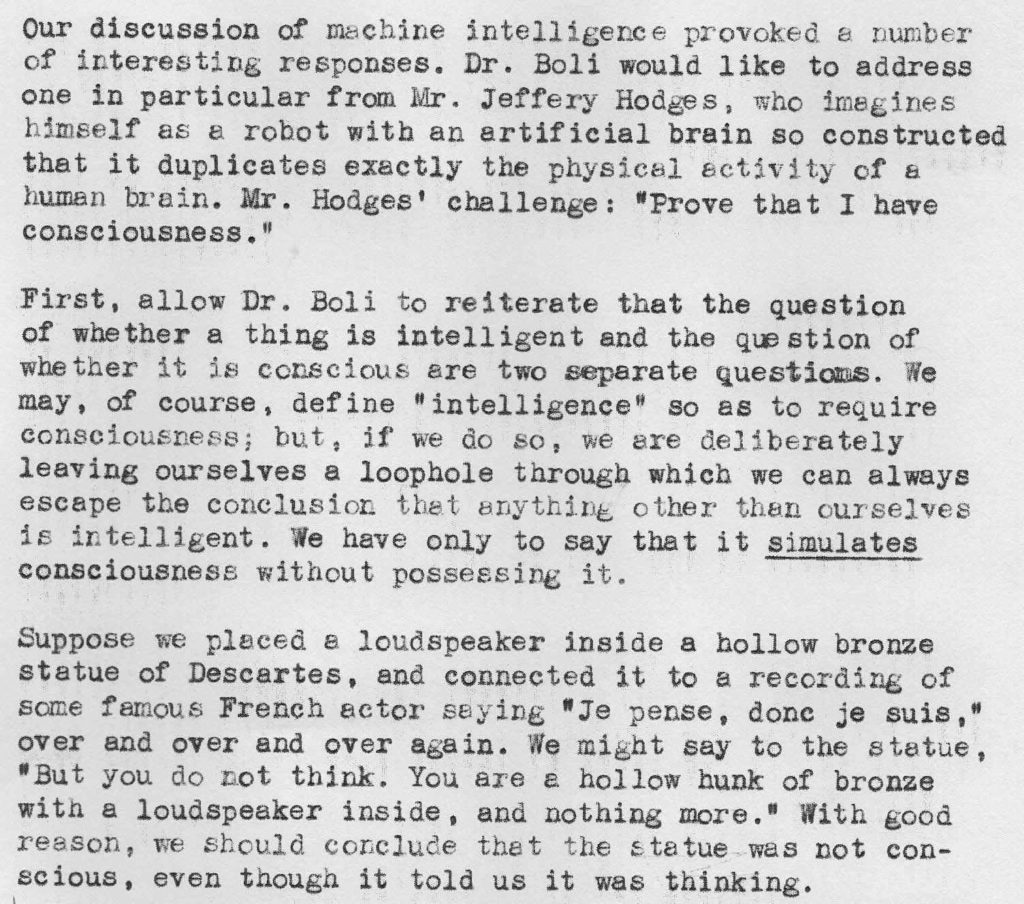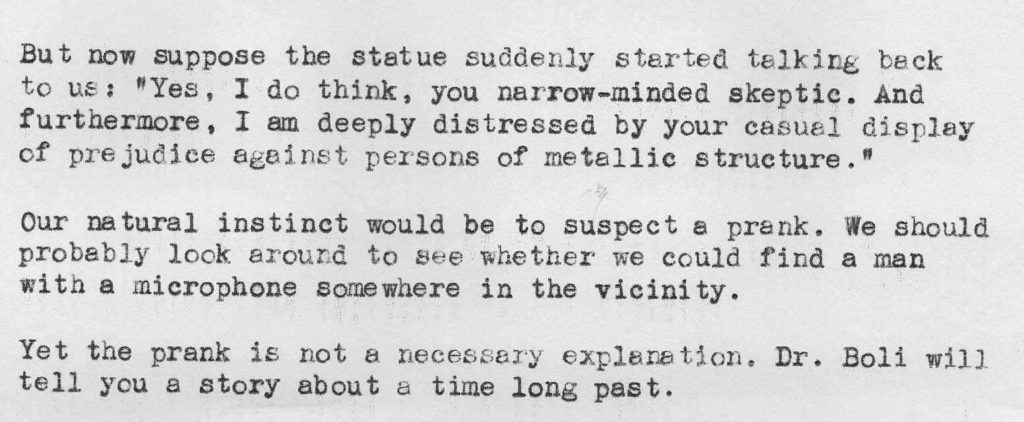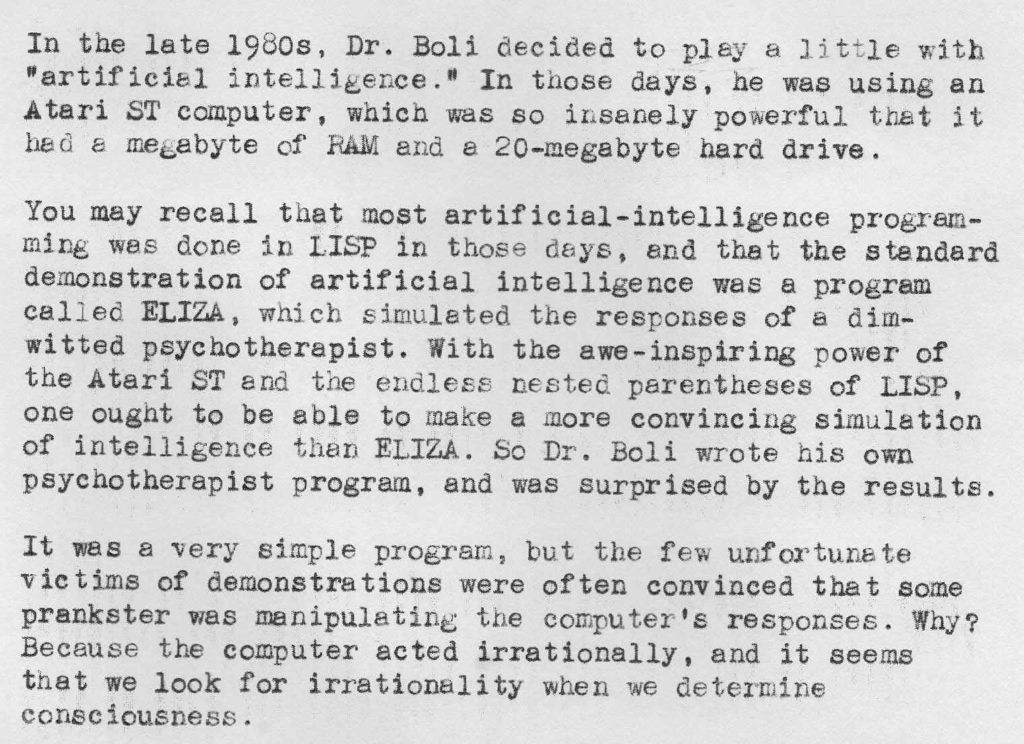


Typewriter: Woodstock.
To make the article searchable and quotable, it is reprinted below.
Our discussion of machine intelligence provoked a number of interesting responses. Dr. Boli would like to address one in particular from Mr. Jeffery Hodges, who imagines himself as a robot with an artificial brain so constructed that it duplicates exactly the physical activity of a human brain. Mr. Hodges’ challenge: “Prove that I have consciousness.”
First, allow Dr. Boli to reiterate that the question of whether a thing is intelligent and the question of whether it is conscious are two separate questions. We may, of course, define “intelligence” so as to require consciousness; but, if we do so, we are deliberately leaving ourselves a loophole through which we can always escape the conclusion that anything other than ourselves is intelligent. We have only to say that it simulates consciousness without possessing it.
Suppose we placed a loudspeaker inside a hollow bronze statue of Descartes, and connected it to a recording of some famous French actor saying “Je pense, donc je suis,” over and over and over again. We might say to the statue, “But you do not think. You are a hollow hunk of bronze with a loudspeaker inside, and nothing more.” With good reason, we should conclude that the statue was not conscious, even though it told us it was thinking.
But now suppose the statue suddenly started talking back to us: “Yes, I do think, you narrow-minded skeptic. And furthermore, I am deeply distressed by your casual display of prejudice against persons of metallic structure.”
Our natural instinct would be to suspect a prank. We should probably look around to see whether we could find a man with a microphone somewhere in the vicinity.
Yet the prank is not a necessary explanation. Dr. Boli will tell you a story about a time long past.
In the late 1980s, Dr. Boli decided to play a little with artificial intelligence.” In those days, he was using an Atari ST computer, which was so insanely powerful that it had a metabyte of RAM and a 20-megabyte hard drive.
You may recall that most artificial-intelligence programming was done in LISP in those days, and that the standard demonstration of artificial intelligence was a program called ELIZA, which simulated the responses of a dim-witted psychotherapist. With the awe-inspiring power of the Atari ST and the endless nested parentheses of LISP, one ought to be able to make a more convincing simulation of intelligence than ELIZA. So Dr. Boli wrote his own psychotherapist program, and was surprised by the results.
It was a very simple program, but the few unfortunate victims of demonstrations were often convinced that some prankster was manipulating the computer’s responses. Why? Because the computer acted irrationally, and it seems we look for irrationality when we determine consciousness.
For example, the program counted the number of occurrences of first-person singular pronouns in the test subject’s typing. After a certain number, it complained that the subject talked about nothing but himself all the time. If the subject veered into an area completely outside the program’s vocabulary (and most areas were completely outside the program’s vocabulary), it would commandeer the conversation with an irrelevance: “That’s fine, but I want to talk about squirrels.” (And you may be sure that it had been given the vocabulary for a discussion of squirrels.)
In this way, the program came very close to passing the Turing test: even though the subjects were told that they were interacting with a computer program, many of them insisted that there was a human being manipulating the computer’s responses. After a while, Dr. Boli decided to add a timed delay before the computer responded, which made the illusion of human manipulation even more plausible.
From this experiment, Dr. Boli concluded that cheap tricks are the best way to make a convincing simulation of consciousness. We seem to believe, against all evidence, that a machine cannot be irrational.
And now, to return to Mr. Hodges’ challenge: Dr. Boli cannot prove that Robot Jeffery Hodges is conscious, because Dr. Boli cannot prove that Human Jeffery Hodges is conscious. Consciousness is not demonstrable; it may be taken on faith, but we have no proof that even the human beings who surround us are not employing cheap tricks to fool us into thinking them conscious. Dr. Boli has demonstrable proof only of his own consciousness; and it is demonstrable to himself, but not to anyone else.
If you are an unconscious being whose continued existence requires the simulation of consciousness, Dr. Boli would advise you to make liberal use of irrationality. It seems to be the most convincing proof of consciousness to the irrational human mind.
